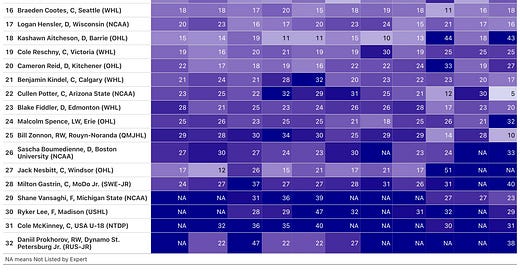Before hockey takes its well-deserved summer break, it’s time to celebrate the future of the sport with the NHL Draft, beginning with Round One at 7p.m. ET tonight at the Peacock Theater in Los Angeles (I’ll be there so please come say hi!). Rounds 2-7 will happen at 11a.m. ET Saturday.
Leading up to the draft are folks with varying degrees of expertise stating who they believe will be drafted in the first few rounds and by whom. Some of these mock drafts are naturally more predictive than others, but if you combine all of that information, often you have a tool that’s even more accurate than any one list. It’s the “wisdom of the crowds” and it’s been a growing part of draft studies in other sports.
of has finely tuned his process of turning more than 3,000 mock drafts and big boards into an aggregated list. Nathaniel Miller has been putting out an NBA version of “wisdom of the crowds” for a few years now. also has an NBA consensus board where he analyzes the differences between how scouts and data scientists rank draftees.I will attempt to do the same thing for hockey. There are a few limitations and provisos with my approach. For starters, this is my first year putting together a consensus board, so determining how much weight deserves to be placed on each mock draft is a mystery; so, the quick answer is to weigh each expert’s work equally. Second, these rankings are actually a combination of mock drafts and big boards, and anyone will probably approach these exercises differently because of team needs and such. It also means some only listed the top 32 while others had a more thorough list. Lastly, all of these lists are freely available.
I have included 11 mock drafts and big boards into this consensus from folks who have put an incredible amount of time into their work:
And now, without further ado, here is the 2025 NHL Consensus Mock Draft:
Here are the biggest takeaways:
With few exceptions, everyone has 17-year-old defenseman Matthew Schaefer as the #1 overall pick. As others have said, he may not be the absolute best top pick in the last several years, but he’s the top of this class.
#2 is also almost unanimous: center Michael Misa, who amassed 134 points with 62 goals in 65 games for the OHL’s Saginaw Spirit.
After the top two, the disagreements begin. Elite Prospects diverged the most on center Anton Frondell, while Tony Ferrari and Will Scouch disagreed most strongly at the top about center Caleb Desnoyers.
When coming up with averages and subsequent rankings, the lowest ranking outside of that expert’s list was used (e.g. Shane Vansaghi was outside of Adam Kimelman’s top 32, so 33 was used). This approach was to avoid causing too massive a swing for any one player.
If the assumptions are that each team will (and should) take the best player available and will not trade from where they are, then this resource could be valuable as is. However, teams often draft because of need. If we still assume no trades but include some positional need (courtesy nhl.com) in a final consensus mock draft, here is how I would envision the first round playing out:
The goal was to make sure that no team strayed too far from the consensus board beyond, say, five picks. There are also good reasons why familiarity with a player may require a slight reach. Finally, when it comes to the consensus board, many things can improve it: more mocks, positional adjustments, different statistical techniques for weighting higher selections more favorably, etc. Still, “wisdom of the crowds” has had a lot of success helping other sports understand how experts view certain players, and hockey should be no exception.





